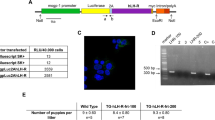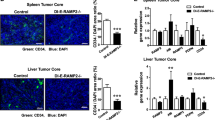Abstract
The angiogenic peptide adrenomedullin (ADM) has been implicated as a mediator of the increased risk of endometrial hyperplasia and cancer resulting from the use of tamoxifen for the treatment and prevention of breast cancer. ADM has been shown to be induced by tamoxifen in the endometrium and to be a growth factor for endometrial endothelial cells in vitro. We have now shown ADM to be strongly angiogenic in the mouse subcutaneous sponge angiogenesis assay. To examine the role of ADM in tumor growth, the ADM cDNA was transfected into endometrial carcinoma cells followed by xenografting into athymic mice. Two endometrial cancer cell lines were employed, those in which transfection and expression of ADM resulted in no effect on growthin vitro (Ishikawa cells) and those in which expressionof exogenous ADM stimulated in vitro growth (RL95.2 cells). A clear enhancement of tumor growth was seen with both cell lines but the effect was far greater with the RL95.2 cells. We conclude that ADM is pro-tumorigenic by stimulating either angiogenesis alone or by stimulating angiogenesis and carcinoma cell growth directly. The combined activities lead to a striking increase in tumor growth. These results provide the first direct evidence of tumorigenic activity of ADM and provide further support for ADMs involvement in tamoxifen induced endometrial neoplasia.
This is a preview of subscription content, access via your institution
Access options
Subscribe to this journal
Receive 50 print issues and online access
$259.00 per year
only $5.18 per issue
Buy this article
- Purchase on Springer Link
- Instant access to full article PDF
Prices may be subject to local taxes which are calculated during checkout






Similar content being viewed by others
Abbreviations
- adrenomedullin:
-
ADM
- calcitonin receptor-like receptor:
-
CRLR
- receptor activity modifying protein 2:
-
RAMP-2
- tamoxifen:
-
TAM
- hypoxia-inducible transcription factor-1:
-
HIF-1
- vascular endothelial growth factor:
-
VEGF
- erythropoietin:
-
EPO
- ER:
-
estrogen receptor
- human dermal microvascular endothelial cells:
-
HDMEC
- endothelial growth medium:
-
EGM
- chick chorioallantoic membrane assay:
-
CAM assay
- optical density:
-
OD
References
Ali SH, O'Donnell AL, Balu D, Pohl MB, Seyler MJ, Mohamed S, Mousa S, Dandona P . 2000 Cancer Res. 60: 7094–7098
Attia M, Weiss D . 1966 Cancer Res., 26: 1787–1800
Bilimoria MM, Assikis VJ, Muenzner HD, Wolf DM, Satyaswaroop PG, Jordan VC . 1996 J. Steroid Biochem Mol. Biol. 58: 479–488
Birner P, Schindl M, Obermair A, Plank C, Breitenecker G, Oberhuber G . 2000 Cancer Res. 60: 4693–4696
Bergman L, Beelen M, Gallee M, Hollema H, Benraadt J, van Leeuwen F . 2000 Lancet 356: 881–887
Caron KM, Smithies O . 2001 Proc. Natl. Acad. Sci. USA 98: 615–619
Cormier-Regard S, Nguyen SV, Claycomb WC . 1998 J. Biol. Chem. 273: 17787–17792
Cuzick JA . 2000 Eur. J. Cancer 36: 1298–1302
Dalton RR, Kallab AM . 2001 South Med. J. 94: 7–15
Fox SB, Leek RD, Weekes MP, Whitehouse RM, Gatter KC, Harris AL . 1995 J. Pathol. 177: 275–283
Garayoa M, Martinez A, Lee S, Pio R, An WG, Neckers L, Trepel J, Montuenga LM, Ryan H, Johnson R, Gassmann M, Cuttitta F . 2000 Mol. Endocrinol. 14: 848–862
Hata K, Takebayashi Y, Akiba S, Fujiwaki R, Lida K, Nakayama K, Nakayama S, Fukumoto M, Miyazaki K . 2000 Mol. Hum. Reprod. 6: 867–872
Hinson JP, Kapas S, Smith DM . 2000 Endocr. Rev. 21: 138–167
Ishimitsu T, Kojima M, Kangawa K, Hino J, Matsuoka H, Kitamura K, Eto T, Matsuo H . 1994 Biochem. Biophys. Res. Commun. 203: 631–639
Kamitani S, Asakawa M, Shimekake Y, Kuwasako K, Nakahara K, Sakata T . 1999 FEBS Lett. 448: 111–114
Kitamura K, Kangawa K, Kawamoto M, Ichiki Y, Nakamura S, Matsuo H, Eto T . 1993 Biochem. Biophys. Res. Commun. 192: 553–560
Kung AL, Wang S, Klco JM, Kaelin WG, Livingston DM . 2000 Nat. Med. 6: 1335–1340
Lal A, Lash AE, Altschul SF, Velculescu V, Zhang L, McLendon RE, Marra MA, Prange C, Morin PJ, Polyak K, Papadopoulos N, Vogelstein B, Kinzler KW, Strausberg RL, Riggins GJA . 1999 Cancer Res. 59: 5403–5407
McLatchie LM, Fraser NJ, Main MJ, Wise A, Brown J, Thompson N, Solari R, Lee MG, Foord SM . 1998 Nature 393: 333–339
Miller MJ, Martinez A, Unsworth EJ, Thiele CJ, Moody TW, Elsasser T, Cuttitta F . 1996 Biol. Chem. 271: 23345–23351
Nakayama M, Takahashi K, Murakami O, Shirato K, Shibahara S . 1998 Biochem. Biophys. Res. Commun. 243: 514–517
Nikitenko LL, Smith DM, Hague S, Wilson CR, Bicknell R, Rees MCP . 2002 Trends in Pharm. Sci in press
Nikitenko LL, MacKenzie IZ, Rees MC, Bicknell R . 2000 Mol. Hum. Reprod. 6: 811–819
Oehler MK, Norbury C, Hague S, Rees MCP, Bicknell R . 2001 Oncogene 20: 2937–2945
Pio R, Martinez A, Unsworth EJ, Kowalak JA, Bengoechea JA, Zipfel PF, Elsasser TH, Cuttitta FJ . 2000 Biol. Chem. 486: 3–
Rocchi P, Boudouresque F, Zamora AJ, Muracciole X, Lechevallier E, Martin PM, Ouafik L . 2001 Cancer Res. 61: 1196–1206
Semenza GL . 1999 Annu. Rev. Cell Dev. Biol. 15: 551–578
Sundareshan P, Hendrix MJC . 1992 In Vitro 28A: 544–552
Walsh DA, Hu DE, Mapp PI, Polak JM, Blake DR, Fan TP . 1996 Histochemical Journal 28: 759–769
Webb P, Lopez GN, Uht RM, Kushner PJ . 1995 Mol. Endocrinol. 9: 443–456
White IN . 1999 Carcinogenesis 20: 1153–1160
Wimalawansa SJ . 1997 Crit. Rev. Neurobiol. 11: 167–239
Zhang L, Rees MCP, Bicknell R . 1995a J. Cell Sci. 108: 323–331
Zhang HT, Craft P, Scott PA, Ziche M, Weich HA, Harris AL, Bicknell R . 1995b J. Natl. Cancer Inst. 87: 213–219
Zhao Y, Hague S, Manek S, Zhang L, Bicknell R, Rees MC . 1998 Oncogene 16: 409–415
Zhong H, De Marzo AM, Laughner E, Lim M, Hilton DA, Zagzag D, Buechler P, Isaacs WB, Semenza GL, Simons JW . 1999 Cancer Res. 59: 5830–5835
Acknowledgements
The authors acknowledge the excellent technical assistance of Sandra Peak, ICRF Clare Hall Laboratories, London in performing the xenograft and sponge assays, Helen Turley, Department of Cellular Science, University of Oxford for help with immunohistochemistry and cytospins and Mr Daryl Harman, Caligen Foam Ltd, Accrington for help in obtaining sponge implants. Financial support was provided by the Imperial Cancer Research Fund, The Deutsche Forschungsgemeinschaft and The Sir Jules Thorn Charitable Trust.
Author information
Authors and Affiliations
Corresponding author
Rights and permissions
About this article
Cite this article
Oehler, M., Hague, S., Rees, M. et al. Adrenomedullin promotes formation of xenografted endometrial tumors by stimulation of autocrine growth and angiogenesis. Oncogene 21, 2815–2821 (2002). https://doi.org/10.1038/sj.onc.1205374
Received:
Revised:
Accepted:
Published:
Issue Date:
DOI: https://doi.org/10.1038/sj.onc.1205374
Keywords
This article is cited by
-
miR-1297 sensitizes glioma cells to temozolomide (TMZ) treatment through targeting adrenomedullin (ADM)
Journal of Translational Medicine (2022)
-
3D tumor angiogenesis models: recent advances and challenges
Journal of Cancer Research and Clinical Oncology (2021)
-
The neuropeptide receptor calcitonin receptor-like (CALCRL) is a potential therapeutic target in acute myeloid leukemia
Leukemia (2019)
-
The Role of the Calcitonin Peptide Family in Prostate Cancer and Bone Metastasis
Current Molecular Biology Reports (2017)
-
Impact of neonatal iron deficiency on hippocampal DNA methylation and gene transcription in a porcine biomedical model of cognitive development
BMC Genomics (2016)



